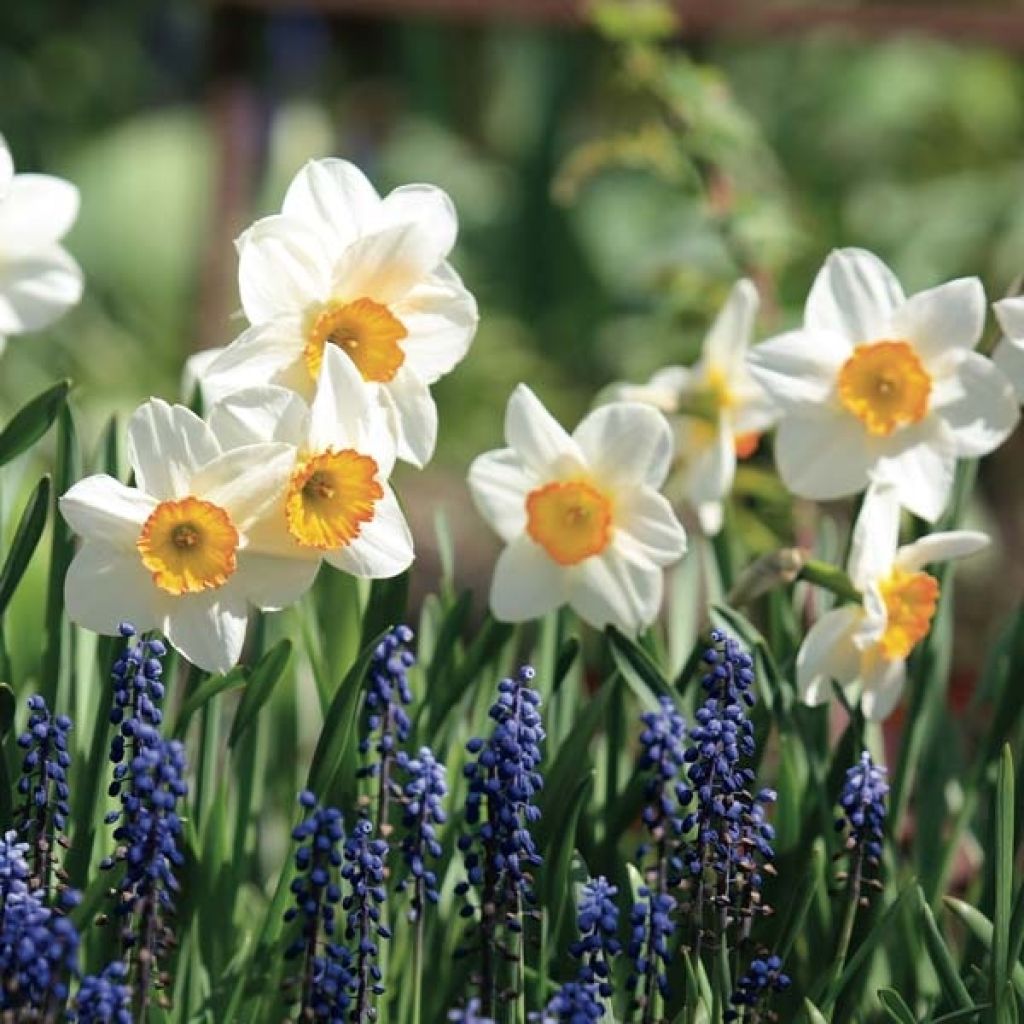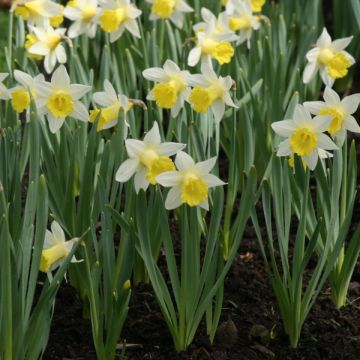

Narcisse Barret Browning
Narcissus Barrett Browning
Narcissus Barrett Browning
Daffodil, Narcissus, Jonquil
Received in excellent condition, well packaged. Good-sized bulbs. Planted in a pot." Analysis: - The translation is accurate and captures the meaning and context of the original text. - There are no spelling or grammar errors. - The tone and register of the original text are maintained in the translation. - The use of "bulbs" instead of "plants" is appropriate in this context, as the original text refers to planting bulbs in a pot. - The use of "pot" instead of "field of plants" is correct, as the original text mentions planting in a pot.
Janet, 16/09/2023
Special offer!
Receive a €20 voucher for any order over €90 (excluding delivery costs, credit notes, and plastic-free options)!
1- Add your favorite plants to your cart.
2- Once you have reached €90, confirm your order (you can even choose the delivery date!).
3- As soon as your order is shipped, you will receive an email containing your voucher code, valid for 3 months (90 days).
Your voucher is unique and can only be used once, for any order with a minimum value of €20, excluding delivery costs.
Can be combined with other current offers, non-divisible and non-refundable.
This plant carries a 6 months recovery warranty
More information
We guarantee the quality of our plants for a full growing cycle, and will replace at our expense any plant that fails to recover under normal climatic and planting conditions.

Would this plant suit my garden?
Set up your Plantfit profile →
Description
The 'Barrett Browning' daffodil, a great classic! Since 1945, it has embellished gardens with its cheerful colours; its pure white petals frame a small crown of very vibrant orange, almost red. Perfect in beds, borders, pots, and bouquets, it is easy to grow and naturalises well. It is an excellent, proven variety.
Originally from Western Europe, daffodils belong to the Amaryllidaceae family. The Narcissus genus includes many species and varieties, of botanical origin (like the poet's daffodil) or horticultural. The jonquil (Narcissus jonquilla), with its yellow flowers and leaves similar to those of rushes, is a species in the Narcissus genus. In certain regions, the yellow daffodil or trumpet daffodil (Narcissus pseudonarcissus) is sometimes called jonquil, hence the frequent confusion between jonquil and daffodil.
The 'Barrett Browning' Daffodil owes its name to the English poet Elizabeth Barrett Browning, wife of the famous poet Robert Browning. Descendant of the Narcissus poeticus, it certainly does not lack poetry! 'Barrett Browning' first bloomed in 1945 in England; today, it is recognized worldwide as one of the best small-cupped daffodils. It is a perennial herbaceous plant with a bulb. At maturity, this vigorously growing variety reaches about 40 cm (16in) high when flowering. Flowering takes place in March-April, lasting about 3 weeks and each flower is approximately 9 cm (4in) wide, composed of a corolla of round, thick petals that slightly overlap. These are pure white, sometimes taking on very pale yellow hues and in the centre, there is a small wavy-edged cup-shaped paracorolla, vivid orange tending towards red. The linear foliage dries up and disappears a few weeks after flowering.
Barret Browning is easy to grow and very hardy and can be planted in various areas in the garden: at the front of a shrub bed, as a border, in the middle of a lawn or in a pot. It pairs wonderfully with euphorbias, grape hyacinths, early tulips, bluebells and will naturalise easily. However, be cautious with young children as the bulb, flower, and leaves are toxic. Daffodils are the most resistant bulbs planted in autumn; they prefer well-drained and light soil but are very accommodating.
For bouquets: We advise against mixing daffodils with other flowers, especially tulips. The stems of daffodils contain a substance that causes other flowers to wilt quickly. This detrimental effect on other flower types can be mitigated by dipping the ends of the daffodil stems in warm water for 1 to 2 minutes.
Report an error about the product description
Plant habit
Flowering
Foliage
Botanical data
Narcissus
Barrett Browning
Amaryllidaceae
Daffodil, Narcissus, Jonquil
Cultivar or hybrid
Other Single Daffodils
View all →Planting and care
Daffodils bloom from March to May and come back every year. They are very easy to grow and thrive in the shade of a wood or a sunny flower bed. Plant them 10 cm (4in) deep and 10 cm (4in) apart, in minimum clusters of 5 bulbs, in uniform or mixed colours. To plant them in the lawn: lift a patch of turf, dig and loosen the soil to a depth of at least 20 cm (8in) (the depth of a spade), place your bulbs, cover them with soil and put the turf back. Choose a spot where you won't mow, as you must let the daffodil leaves wither before cutting them. This is when the bulb rebuilds itself and prepares the flowers for the following year. However, remember to cut the flowers as soon as they fade to prevent seed formation, which would unnecessarily exhaust the bulb.
Planting period
Intended location
Care
-
, onOrder confirmed
Reply from on Promesse de fleurs
Haven't found what you were looking for?
Hardiness is the lowest winter temperature a plant can endure without suffering serious damage or even dying. However, hardiness is affected by location (a sheltered area, such as a patio), protection (winter cover) and soil type (hardiness is improved by well-drained soil).

Photo Sharing Terms & Conditions
In order to encourage gardeners to interact and share their experiences, Promesse de fleurs offers various media enabling content to be uploaded onto its Site - in particular via the ‘Photo sharing’ module.
The User agrees to refrain from:
- Posting any content that is illegal, prejudicial, insulting, racist, inciteful to hatred, revisionist, contrary to public decency, that infringes on privacy or on the privacy rights of third parties, in particular the publicity rights of persons and goods, intellectual property rights, or the right to privacy.
- Submitting content on behalf of a third party;
- Impersonate the identity of a third party and/or publish any personal information about a third party;
In general, the User undertakes to refrain from any unethical behaviour.
All Content (in particular text, comments, files, images, photos, videos, creative works, etc.), which may be subject to property or intellectual property rights, image or other private rights, shall remain the property of the User, subject to the limited rights granted by the terms of the licence granted by Promesse de fleurs as stated below. Users are at liberty to publish or not to publish such Content on the Site, notably via the ‘Photo Sharing’ facility, and accept that this Content shall be made public and freely accessible, notably on the Internet.
Users further acknowledge, undertake to have ,and guarantee that they hold all necessary rights and permissions to publish such material on the Site, in particular with regard to the legislation in force pertaining to any privacy, property, intellectual property, image, or contractual rights, or rights of any other nature. By publishing such Content on the Site, Users acknowledge accepting full liability as publishers of the Content within the meaning of the law, and grant Promesse de fleurs, free of charge, an inclusive, worldwide licence for the said Content for the entire duration of its publication, including all reproduction, representation, up/downloading, displaying, performing, transmission, and storage rights.
Users also grant permission for their name to be linked to the Content and accept that this link may not always be made available.
By engaging in posting material, Users consent to their Content becoming automatically accessible on the Internet, in particular on other sites and/or blogs and/or web pages of the Promesse de fleurs site, including in particular social pages and the Promesse de fleurs catalogue.
Users may secure the removal of entrusted content free of charge by issuing a simple request via our contact form.
The flowering period indicated on our website applies to countries and regions located in USDA zone 8 (France, the United Kingdom, Ireland, the Netherlands, etc.)
It will vary according to where you live:
- In zones 9 to 10 (Italy, Spain, Greece, etc.), flowering will occur about 2 to 4 weeks earlier.
- In zones 6 to 7 (Germany, Poland, Slovenia, and lower mountainous regions), flowering will be delayed by 2 to 3 weeks.
- In zone 5 (Central Europe, Scandinavia), blooming will be delayed by 3 to 5 weeks.
In temperate climates, pruning of spring-flowering shrubs (forsythia, spireas, etc.) should be done just after flowering.
Pruning of summer-flowering shrubs (Indian Lilac, Perovskia, etc.) can be done in winter or spring.
In cold regions as well as with frost-sensitive plants, avoid pruning too early when severe frosts may still occur.
The planting period indicated on our website applies to countries and regions located in USDA zone 8 (France, United Kingdom, Ireland, Netherlands).
It will vary according to where you live:
- In Mediterranean zones (Marseille, Madrid, Milan, etc.), autumn and winter are the best planting periods.
- In continental zones (Strasbourg, Munich, Vienna, etc.), delay planting by 2 to 3 weeks in spring and bring it forward by 2 to 4 weeks in autumn.
- In mountainous regions (the Alps, Pyrenees, Carpathians, etc.), it is best to plant in late spring (May-June) or late summer (August-September).
The harvesting period indicated on our website applies to countries and regions in USDA zone 8 (France, England, Ireland, the Netherlands).
In colder areas (Scandinavia, Poland, Austria...) fruit and vegetable harvests are likely to be delayed by 3-4 weeks.
In warmer areas (Italy, Spain, Greece, etc.), harvesting will probably take place earlier, depending on weather conditions.
The sowing periods indicated on our website apply to countries and regions within USDA Zone 8 (France, UK, Ireland, Netherlands).
In colder areas (Scandinavia, Poland, Austria...), delay any outdoor sowing by 3-4 weeks, or sow under glass.
In warmer climes (Italy, Spain, Greece, etc.), bring outdoor sowing forward by a few weeks.

































